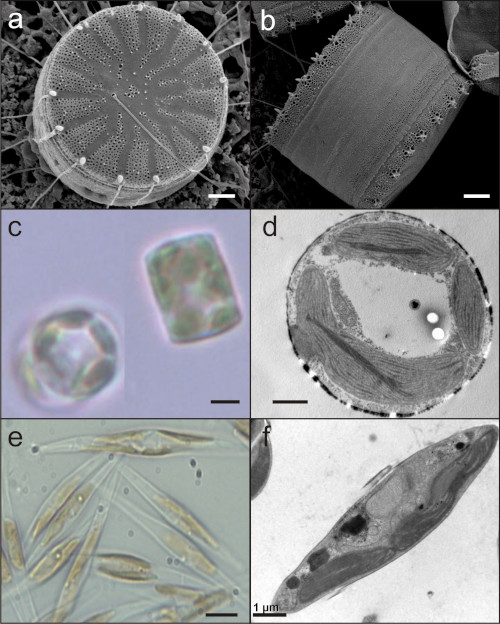Research
Structure and function of photosynthetic protein complexes in eukaryotes
The molecular mechanisms of adaptation of the photosynthetic apparatus to changing light conditions are our main interests, whereby we focus on diatoms.

Regulation of light harvesting in diatoms
Diatoms are unicellular, eukaryotic algae, which are interesting due to the following reasons: they are responsible for about 25% of the world's primary production and are one of the major carbon sinks in the oceans. The regulation of the light reactions of photosynthesis of these organisms is the focus of our research. Especially their ability to switch from light-harvesting to photoprotection is one of the reasons for their big success in the marine environment, despite lacking own means for mobility. Diatoms can be genetically manipulated; thus we use methods for overexpression of tagged proteins or down-regulate the expression of genes by RNAi or CRISPR-Cas. In addition, general biochemical and spectroscopic methods are used to analyse the structure and function of the proteins, and their interaction in protein complexes. To visualise the protein structures we also use electron microscopical methods.

 Organisation of the light
harvesting proteins of T. pseudonana and C. meneghiniana (adopted from Arshad et
al. 2021) in Photosystem I (a), Photosystem II (b) and in the free FCP-complexes
FCPa and FCPb, (c). Different colors denote FCPs from different protein
families.
Organisation of the light
harvesting proteins of T. pseudonana and C. meneghiniana (adopted from Arshad et
al. 2021) in Photosystem I (a), Photosystem II (b) and in the free FCP-complexes
FCPa and FCPb, (c). Different colors denote FCPs from different protein
families. The role of photoreceptors in light regulation of diatoms
Light is not only used for photosynthesis, but also an important signal in gene regulation received by receptor molecules. In diatoms genes for cryptochromes can be found. Cryptochromes can absorb blue light, and are working as receptors and/or function in DNA repair. We were the first to characterise a so-called “plant-like cryptochrome", CryP. Members of this protein family have meanwhile be found in many phylogenetic groups. CryP is involved in the gene regulation in many ways. At the moment we are elucidating the signal transduction pathway.

Characteristics
of CryP. The redox state of the FAD bound depends on the presence of the C-terminal extension
(CTE) (a). CryP as a dimer can bind two proteins (b), a protein specific for
diatoms and a transcription factor; BolA (adopted from Krischer
et al. 2022).
Diatoms in biotechnology
In addition, diatoms are rather interesting in biotechnological research due to their ability to e.g. produce lipids in high amounts and especially lipids containing poly-unsaturated fatty acids. In further projects we genetically modified diatoms to increase the triacylglycerid and/or the omega-3-fatty acid production.
The projects were embedded in a DFG Research Group (Specific light driven reactions in unicellular model algae, FOR 1261) and a Marie Curie Training and Research Network of the EU, “Solar Energy to Biomass – Optimisation of light energy conversion in plants and microalgae- SE2B“ (http://www.uni-frankfurt.de/se2b), which was co-ordinated by us. In addition, close collaboration exist inside und and outside the Goethe University (in the framework of the projects mentioned above).
Contact
Plant Cell Phyiology
Prof. Dr. Claudia Büchel
Biocentre, Campus Riedberg
Building 210, Raum 202
Max-von-Laue-Str. 9
60438 Frankfurt am Main
T +49 69 798-29602
F +49 69 798-29600
E c.buechel@bio.uni-frankfurt.de
consultation-hour
on appointment via email
Secretary
Susanne Horst
T +49 69 798-29601
E su.horst@bio.uni-frankfurt.de

Unsere Webseite in deutsch.
- Studying at Goethe University
- International applicants
- Faculties
- Overview of study programmes
- Programme for refugees
- GRADE
- Goethe Business School (continuing education)
- Research at Goethe University
- Scientific news
- Goethe Welcome Center (for international researchers)
- Collaborative research projects
- Individual research
- Visiting fellowships
- Endowed chairs
- About the University
- News-in-brief
- University administration
- Campus locations
- Campus life
- University archives (German)
- Rhine-Main-Universities





